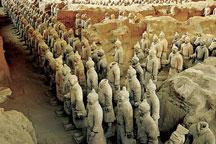Watch Video

 Play Video
Play Video
Xi'an, the capital city of West China's Shaanxi Province, is world famous for Qin Shi Huang's Mausoleum, otherwise known as the site of the Terracotta Warriors. Designated a World Heritage Site by UNESCO in 1987, the mausoleum is the largest underground Imperial tomb ever discovered. And recently, archaeologists have made some new finds.
At the Emperor Qinshihuang's Mausoleum Site Museum, some newly-restored stone armour is now on display. Each piece of armour is in a different shape and is connected by bronze wires, to ensure its flexibility
At the Emperor Qinshihuang's Mausoleum Site Museum, some newly-restored stone armour is now on display. Each piece of armour is in a different shape and is connected by bronze wires, to ensure its flexibility.
"This is the first collection of amour we restored. It consists of 612 pieces, and is divided into three parts. Each piece has small holes for the bronze wire to pass through and is delicately designed. Take a look at this helmet. It was made to fit the shape of our face. It's a very human design," Zhang Weixing, Deputy Director of Emperor Qinshihuang's Mausoleum Site Museum, says.
This is the first time armour from the Qin Dynasty has been found. And there is certainly a large stash.
The area archaeologists are planning to work on covers some 13,000 square meters. But only 500 square meters has been excavated so far.
"In this area, we found dozens of pieces of stone armour, including helmets. They are displayed here in four lines," an archaeologist says.
So far, 87 pieces have been found. But archaeologists predict that the total amount could exceed 6000. Although they look similar to us, specialists say they can see a strict principal of hierarchy from the designs.
"These pieces of armour are quite large and rough, but those pieces are very delicate. The large pieces were for soldiers, and the delicate ones were worn by army generals," an archaeologist says.
Besides armour and helmets, archaeologists have also discovered armour for horses, and spare parts from carriages. These finds indicate that a huge armour storehouse is part of the sprawling Emperor Qinshihuang's Mausoleum.
Source: CCTV December 17, 2013]


No comments:
Post a Comment